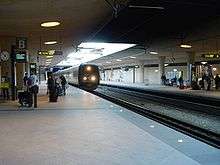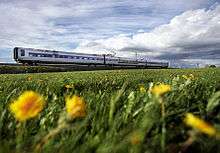Øresundståg
Øresundståg (Danish pronunciation: [ˈøːɐsɔnsˌtsʰɔˀw], Swedish pronunciation: [œrɛˈsɵ̂nːdsˌtoːɡ]) is a passenger train network operated by DSB and Transdev in the transnational Øresund Region of Denmark and Sweden. The name is a hybrid of the Danish Øresundstog and the Swedish Öresundståg, both meaning "Øresund train". The rolling stock, also known as Class ET in Denmark and X31K or X32K in Sweden, are electric passenger trainsets in the Flexliner family. The maximum speed is 180 km/h.
An Øresundståg at Copenhagen Central Station | ||||||||||||||||||||||||||||||||||||||||||||||||||||||||||||||||||||||||||||||||||||||||||||||||||||||||||||||||||||||||||||||||||||||||||||||||||||||||||||||||||||||||||||||||||||||||||||||||||||||||||||||||||||||||||||||||||||||||||||||||||||||||||||||||||||||||||||||||||||||||||||||||||||||||||||||||||||||||||||||||||||||||||||||||||||||||||||||||||||||||||||||||||||||||||||||||||||||||||||||||||||||||||||||||||||||||||||||||||||||||||||||||||||||||||||||||||||||||||||||||||||||||||||||||||||||||||||
| Overview | ||||||||||||||||||||||||||||||||||||||||||||||||||||||||||||||||||||||||||||||||||||||||||||||||||||||||||||||||||||||||||||||||||||||||||||||||||||||||||||||||||||||||||||||||||||||||||||||||||||||||||||||||||||||||||||||||||||||||||||||||||||||||||||||||||||||||||||||||||||||||||||||||||||||||||||||||||||||||||||||||||||||||||||||||||||||||||||||||||||||||||||||||||||||||||||||||||||||||||||||||||||||||||||||||||||||||||||||||||||||||||||||||||||||||||||||||||||||||||||||||||||||||||||||||||||||||||||
|---|---|---|---|---|---|---|---|---|---|---|---|---|---|---|---|---|---|---|---|---|---|---|---|---|---|---|---|---|---|---|---|---|---|---|---|---|---|---|---|---|---|---|---|---|---|---|---|---|---|---|---|---|---|---|---|---|---|---|---|---|---|---|---|---|---|---|---|---|---|---|---|---|---|---|---|---|---|---|---|---|---|---|---|---|---|---|---|---|---|---|---|---|---|---|---|---|---|---|---|---|---|---|---|---|---|---|---|---|---|---|---|---|---|---|---|---|---|---|---|---|---|---|---|---|---|---|---|---|---|---|---|---|---|---|---|---|---|---|---|---|---|---|---|---|---|---|---|---|---|---|---|---|---|---|---|---|---|---|---|---|---|---|---|---|---|---|---|---|---|---|---|---|---|---|---|---|---|---|---|---|---|---|---|---|---|---|---|---|---|---|---|---|---|---|---|---|---|---|---|---|---|---|---|---|---|---|---|---|---|---|---|---|---|---|---|---|---|---|---|---|---|---|---|---|---|---|---|---|---|---|---|---|---|---|---|---|---|---|---|---|---|---|---|---|---|---|---|---|---|---|---|---|---|---|---|---|---|---|---|---|---|---|---|---|---|---|---|---|---|---|---|---|---|---|---|---|---|---|---|---|---|---|---|---|---|---|---|---|---|---|---|---|---|---|---|---|---|---|---|---|---|---|---|---|---|---|---|---|---|---|---|---|---|---|---|---|---|---|---|---|---|---|---|---|---|---|---|---|---|---|---|---|---|---|---|---|---|---|---|---|---|---|---|---|---|---|---|---|---|---|---|---|---|---|---|---|---|---|---|---|---|---|---|---|---|---|---|---|---|---|---|---|---|---|---|---|---|---|---|---|---|---|---|---|---|---|---|---|---|---|---|---|---|---|---|---|---|---|---|---|---|---|---|---|---|---|---|---|---|---|---|---|---|---|---|---|---|---|---|---|---|---|---|---|---|---|---|---|---|---|---|---|---|---|---|---|---|---|---|---|---|---|---|---|---|---|---|---|---|---|---|---|---|---|---|---|---|---|---|---|---|---|---|---|---|---|---|---|---|---|---|---|---|---|---|---|---|---|---|---|---|---|---|---|---|---|---|---|---|---|---|---|---|---|---|---|---|---|---|---|---|---|---|---|---|---|---|---|
| Locale | Øresund Region | |||||||||||||||||||||||||||||||||||||||||||||||||||||||||||||||||||||||||||||||||||||||||||||||||||||||||||||||||||||||||||||||||||||||||||||||||||||||||||||||||||||||||||||||||||||||||||||||||||||||||||||||||||||||||||||||||||||||||||||||||||||||||||||||||||||||||||||||||||||||||||||||||||||||||||||||||||||||||||||||||||||||||||||||||||||||||||||||||||||||||||||||||||||||||||||||||||||||||||||||||||||||||||||||||||||||||||||||||||||||||||||||||||||||||||||||||||||||||||||||||||||||||||||||||||||||||||
| Technical | ||||||||||||||||||||||||||||||||||||||||||||||||||||||||||||||||||||||||||||||||||||||||||||||||||||||||||||||||||||||||||||||||||||||||||||||||||||||||||||||||||||||||||||||||||||||||||||||||||||||||||||||||||||||||||||||||||||||||||||||||||||||||||||||||||||||||||||||||||||||||||||||||||||||||||||||||||||||||||||||||||||||||||||||||||||||||||||||||||||||||||||||||||||||||||||||||||||||||||||||||||||||||||||||||||||||||||||||||||||||||||||||||||||||||||||||||||||||||||||||||||||||||||||||||||||||||||||
| Track gauge | 1,435 mm (4 ft 8 1⁄2 in) | |||||||||||||||||||||||||||||||||||||||||||||||||||||||||||||||||||||||||||||||||||||||||||||||||||||||||||||||||||||||||||||||||||||||||||||||||||||||||||||||||||||||||||||||||||||||||||||||||||||||||||||||||||||||||||||||||||||||||||||||||||||||||||||||||||||||||||||||||||||||||||||||||||||||||||||||||||||||||||||||||||||||||||||||||||||||||||||||||||||||||||||||||||||||||||||||||||||||||||||||||||||||||||||||||||||||||||||||||||||||||||||||||||||||||||||||||||||||||||||||||||||||||||||||||||||||||||
| ||||||||||||||||||||||||||||||||||||||||||||||||||||||||||||||||||||||||||||||||||||||||||||||||||||||||||||||||||||||||||||||||||||||||||||||||||||||||||||||||||||||||||||||||||||||||||||||||||||||||||||||||||||||||||||||||||||||||||||||||||||||||||||||||||||||||||||||||||||||||||||||||||||||||||||||||||||||||||||||||||||||||||||||||||||||||||||||||||||||||||||||||||||||||||||||||||||||||||||||||||||||||||||||||||||||||||||||||||||||||||||||||||||||||||||||||||||||||||||||||||||||||||||||||||||||||||||

Operations
Three trains per hour cross the Øresund Bridge each way. Trains run at 20-minute intervals (hourly during the night between Østerport and Lund) between Helsingør and Copenhagen in Denmark, and Malmö and Lund in southern Sweden in the region called Scania (over the Coast Line and the Øresund Line, through the City Tunnel, and also on a small part of the Southern Main Line). This increases to six trains per hour during the rush hour, each train consisting of up to three sets coupled together, creating 79-metre-long trains each with 237 seats, providing a capacity of 2133 (4266) seats per hour.
Increasingly this has turned out to be insufficient, and people have to stand during rush hours (into Copenhagen in the morning and Malmö in the afternoon). The differences in salaries and house prices between Copenhagen and Malmö have made cross-border commuting more attractive. The trains cannot be lengthened because of platform length constraints. Earlier, the number of trains was limited to three per hour per direction, owing to the need to reverse at Malmö Central Station ("Malmö C"), which restricted capacity. This restriction has been removed by the opening of the Malmö City Tunnel in 2010. Still, some stations restrict capacity because there are only two tracks shared with other trains (mainly Triangeln, Kastrup Airport and Nørreport), so increasing frequency beyond six trains per hour is not possible.
From Lund most Øresundståg services continue to either Gothenburg, Kalmar, or Karlskrona, using the West Coast Line, the Southern Main Line, the Coast-to-Coast Line or the Blekinge Coast Line. This schedule is augmented by a weekday service between Nivå and Copenhagen Airport, Kastrup with some rush-hour services continuing across the Øresund to Malmö and Lund, effectively giving a 10-minute frequency on the route between Lund and Copenhagen Central Station and even more frequent service between Helsingør and Copenhagen. The network thus covers route 854 kilometres (531 mi) of railway. The section from Lund C to Østerport Station is 24/7 (there is an hourly late night service) and the trip lasts exactly 60 minutes.[1]
The trains are operated by DSB in Denmark and Transdev in Sweden. Trains operated by DSB on the inter-city line to Ystad also run over the network, where they connect to the high-speed ferry to Bornholm. This connection (train + ferry) is considered to be a DSB inter-city service for ticketing purposes. The travel time to Bornholm has been cut in half (3 hours, as against 6 hours previously) since opening of the Øresund Bridge and the introduction of a high-speed ferry, making the combined service more competitive with air travel (35 minutes' flying-time plus 30 minutes' check-in time). Passengers can encounter both Danish and Swedish staff on the trains over the Øresund Bridge. Tickets can be bought from either country. For travel inside one of the Swedish counties or inside Denmark, the local traffic authority tickets are used. For travel across county borders special Øresundståg tickets are used, which are sold by the local traffic authority at selected locations.
On 27 June 2007 it was decided that DSBFirst was to assume responsibility from 2009 for the running of all Øresundståg services on the Øresund Line and connected destinations. DSBFirst started operations on 11 January 2009. In 2011, the Danish and Swedish ministries of transport instructed DSBFirst Sweden to cease operating the Swedish part of the service from 10 December 2011[2][3] Veolia Transport took over the Swedish side and DSBFirst Denmark's services passed to DSB Øresund. The Øresundståg operation has suffered from financial problems as well as delays and cancelled trains on both the Danish and Swedish part of its network,[4][5][6][7] notably during the 2010 winter.

On the Danish side the trains stop often, about every 4 km, like a commuter train. On the Swedish side the trains stop much less often, more like inter-city trains, and they reach stations about 300 km from Copenhagen, such as Gothenburg, Kalmar and Karlskrona. Most travellers in Sweden use it like a regional train for work commuting and similar shorter journeys, and local monthly passes are valid on the train.
The combination of routes of an inter-city nature in Sweden with commuter-like routes in Denmark is often a source of trouble. The long-distance trains from Sweden often accumulate delays during the long journey. But delays cause trouble to commuter passengers having fixed work hours and not wishing to add long margins, since they travel every day. Therefore, DSBFirst nowadays have stand-by trains ready at Kastrup that run to Helsingør if the train from Sweden is delayed. In these circumstances the train from Sweden is terminated early and does not continue to Helsingør.
Because of the complexity involved in the Øresundståg operation and the result of delays on the Danish side of the network, the decision has been taken to split the operations when the current concession ends in December 2021.[8] The Danish services would be tendered by the Danish authorities, while Skånetrafiken will be responsible for the tendering process for the international and Swedish services.
Competitors
Between Gothenburg and Malmö (until 2012 to Copenhagen, but not to Helsingør), SJ AB (the Swedish national railway) operates competing trains. From 2009 they have different tickets compared to the Øresundståg services. SJ runs X2000 trains via Hässleholm, and from 2009-2011 SJ ran intercity IC3 (X31) trains using via Helsingborg. Confusingly, the IC3 train type is often referred to as the "Öresundståg". Different tickets are needed. A similar situation is with the DSB trains to Ystad, which do not accept Øresundståg tickets despite the "Øresundstog" nickname often given to the rolling stock used.
ID checks from Denmark to Sweden
In response to the European migrant crisis the Swedish government mandated ID checks on all trains coming from Denmark from December 2015. As checks performed by the Swedish police took up to 20 minutes per train, timetables were severely disrupted. Beginning on 4 January 2016, transport operators would be fined if any improperly documented people were found to be brought into Sweden. As a result, DSB restructured the timetable, constructed a fence between the platforms at CPH Airport station, and introduced its own ID checks in order to gain entrance to the Malmö-bound platform at CPH Airport station. The frequency of trains across the bridge has been reduced to a maximum of 3 tph. Apart from the reduced frequency, services from Sweden to Denmark run as usual to Helsingør during the day and Østerport in the evenings, with no ID checks entering Denmark. Since 4 May 2017 the line had changed to perform ID checks only at Malmö Hyllie station for trains travelling to Sweden. To travel from København H to CPH Airport, passengers could use the Copenhagen S-trains or the 3tph shuttle between CPH Airport and Nivå (which runs to Helsingør at a lower frequency in the evenings when trains from Sweden do not go farther). This shuttle reverses on the Danish-bound platform at CPH Airport, and maintains a 6tph service north of København H.[9][10]
On the Swedish side, trains are timetabled to wait 20 minutes at Malmö Hyllie where the Swedish police check ID of alighting passengers (who could change to a Pågatåg service to reach their destination faster), then board to check the ID of remaining passengers.[11][12]
Rolling stock
ET / X31K
The trains used are the fourth and latest generation of the IC3 family of multiple units, specifically designed for use in regional traffic in areas connected by the Øresund Line. They are electrically powered, and can run on both the Danish power supply (25 kV 50 Hz AC) and the Swedish power supply (15 kV 16⅔ Hz AC). Named Contessa by its manufacturer Bombardier,[13] they are designated Litra ET in Denmark and Littera X31K (where X means electric multiple unit, and K means allowed to go to Copenhagen) in Sweden. The chassis is manufactured entirely of stainless steel, painted in a light shade of gray. Roughly half of the trains are owned by DSB and the other half by Transdev.
They are multiple units manufactured by Bombardier Transportation in Kalmar, previously known as Kalmar Verkstad and lately in Hennigsdorf by LEW Hennigsdorf.
Each trainset is 79 metres long and weighs about 157 tonnes. The trainset consists of three carriages, giving a weight of about 52 tonnes per unit. Eight of the train's 12 axles are powered, which gives good acceleration. The train's top speed is 180 km/h. Each train costs 67 million Swedish kronor (2006), equivalent to 22 million kronor per unit.
The trainset has a total of 237 seats (79 per carriage), of which some are in a low floor carriage in the middle.
The train type is nicknamed "Øresundstog / Öresundståg" (Danish / Swedish), but they are used not only for services on the Øresundståg network, but also for some local Scania traffic, for the DSB intercity trains Copenhagen-Ystad, and formerly for some of SJ's Copenhagen-Gothenburg intercity trains. Even though these other trains do not in fact form part of the Øresundståg network, they often referred to by that name. In the summertime they are nicknamed "the longest sauna in Sweden" due to inoperative climate control.
X32
Due to a higher demand for comfort on the long-distance trains serving the line between Malmö and Ängelholm, SJ introduced the short-lived X32, a long-distance version of the X31. It had better comfort at the cost of less capacity. The second class section used seats from the first class section of the X31, while the first class section in the X32 used a more classic interior similar to the X2000 highspeed EMU. These trainsets entered service in 2006 and did not have permission to go to Denmark due to the interior being unsuitable for the commuter services in Denmark. However, as more passengers started commuting between Denmark and Sweden, there was a need for extra trainsets so in 2007 all X32 were rebuilt into standard X31 sets.
References
- "Rejseplanen". www.rejseplanen.dk.
- "Børsen". borsen.dk.
- "DSBFirst får dødsstødet af KPMG".
- "Forsinkede DSB-tog skaber vrede i Sverige".
- "Millionbonus til DSBFirst trods flere forsinkelser på kystbanen". 11 May 2010.
- "DSBFirst forårsager masseaflysninger i Sverige". 5 July 2011.
- "Cross-Øresund services to be split". Railway Gazette. 18 December 2017.
- "Archived copy". Archived from the original on 2016-02-02. Retrieved 2016-02-09.CS1 maint: archived copy as title (link)
- "ID-kontrol". www.dsb.dk.
- Anonymous (6 December 2016). "Temporary Reintroduction of Border Control - Migration and Home Affairs - European Commission". Migration and Home Affairs - European Commission.
- http://eur-lex.europa.eu/legal-content/EN/TXT/PDF/?uri=CELEX:32017D0818&from=EN
- "Contessa Electric Multiple Unit - Denmark and Sweden". Retrieved 2008-07-30.
External links
- Official Swedish website of Öresundståg (in English and Swedish)